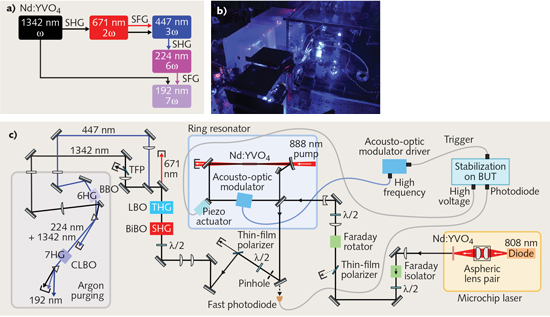DUV by seventh-harmonic generation
An attractive alternative to reach the DUV spectral range below 200 nm is the cascaded SHG and SFG of 1342 nm neodymium yttrium vanadate (Nd:YVO4) lasers up to the seventh harmonic at 191.7 nm. This is especially interesting for the fabrication of FBGs, which does not require a specific wavelength in the DUV spectral range.
In this conversion scheme, there are four conversion stages that generate the second harmonic at 671 nm in bismuth borate (SHG in BiBO), the third harmonic at 447 nm by sum frequency mixing the second harmonic with the fundamental (THG in LBO), the sixth harmonic at 224 nm by frequency doubling the third harmonic (6HG in BBO), and finally the seventh harmonic by sum frequency mixing the sixth harmonic with the fundamental (7HG in CLBO) to create a 191.7 nm DUV light source (see Fig. 1).

FIGURE 1. The conversion scheme (a) is detailed for generating the seventh harmonic of the 1342 nm Nd:YVO4 laser, producing a single-mode deep-ultraviolet (DUV) laser system (b) created by the experimental setup (c).
The first two conversion stages use non-critical phase matching, allowing use of long crystals without the detrimental effects of walk-off and limited-angle-acceptance bandwidth. These cascaded, high-harmonic generation methods have allowed our team at Photonik-Zentrum Kaiserslautern to demonstrate both a broadband and a single-longitudinal mode DUV source.
Broadband DUV
The broadband setup was based on a multi-longitudinal mode Q-switched 1342 nm Nd:YVO4 laser that provided an average power of 15.2 W and a pulse duration of 16.3 ns with a pulse repetition frequency of 10 kHz and a spectral width of 29 GHz.1 The laser had very low pulse energy fluctuations of <1% and diffraction-limited beam quality (m2 <1.1).
The frequency tripling stage was optimized by exploiting the nonlinear phase shift of a phase-mismatched SHG process.2 In principle, this phase shift is caused by the superposition of the non-converted fundamental with the fundamental mode, which is generated by back conversion of the second harmonic. This nonlinear phase shift is the reason for Kerr-like self-action of the fundamental beam. With this self-action, the beam diameter of the second harmonic and the fundamental in the THG crystal could be matched, which improves the beam quality of the third harmonic significantly. By detuning the phase-matching temperature of the SHG crystal, the conversion efficiency from the fundamental to the third harmonic as well as the beam quality of the third harmonic is maximized by optimizing the power ratio of the fundamental to the second harmonic and the spatial overlapping.
We used a polarization bypass in front of the SHG stage to bypass a part of the 1342 nm power to avoid the usage of the residual 1342 nm beam in the last conversion stage. In contrast to the residual beam, the bypassed 1342 nm beam has excellent beam quality, which improves the performance and the beam quality of the 7HG conversion stage. For a bypass of 38%, a power of up to 240 mW at 191.7 nm has been demonstrated—corresponding to an overall efficiency of 1.8%. At a total pump power of 9.45 W after the variable attenuator, we obtained a power of 190 mW (2% overall efficiency) with a Gaussian-shaped beam profile and m2 <1.9.
An even-better beam quality of m2 <1.7 is demonstrated with a bypass of 25% and a total pump power of 8 W, resulting in 155 mW at 191.7 nm. The pulse duration of the seventh harmonic is 12.1 ns and the pulse energy fluctuations are quite high (<10%) because of the multi-longitudinal-mode operation.
